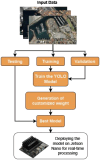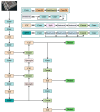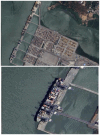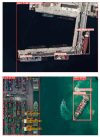Edge computing for detection of ship and ship port from remote sensing images using YOLO
- PMID: 39981193
- PMCID: PMC11839658
- DOI: 10.3389/frai.2025.1508664
Edge computing for detection of ship and ship port from remote sensing images using YOLO
Abstract
In marine security and surveillance, accurately identifying ships and ship ports from satellite imagery remains a critical challenge due to the inefficiencies and inaccuracies of conventional approaches. The proposed method uses an enhanced YOLO (You Only Look Once) model, a robust real-time object detection method. The method involves training the YOLO model on an extensive collection of annotated satellite images to detect ships and ship ports accurately. The proposed system delivers a precision of 86% compared to existing methods; this approach is designed to allow for real-time deployment in the context of resource-constrained environments, especially with a Jetson Nano edge device. This deployment will ensure scalability, efficient processing, and reduced reliance on central computing resources, making it especially suitable for maritime settings in which real-time monitoring is vital. The findings of this study, therefore, point out the practical implications of this improved YOLO model for maritime surveillance: offering a scalable and efficient solution to strengthen maritime security.
Keywords: R-CNN; You Only Look Once (YOLO); deep learning; edge computing; satellite imagery; ship detection; ship-port detection.
Copyright © 2025 Sanikommu, Marripudi, Yekkanti, Divi, Chandrakanth and Mahindra.
Conflict of interest statement
The authors declare that the research was conducted in the absence of any commercial or financial relationships that could be construed as a potential conflict of interest.
Figures
References
-
- Cai Z., Fan Q., Feris R. S., Vasconcelos N. (2016). “A unified multi-scale deep convolutional neural network for fast object detection,” in Computer Vision–ECCV 2016: 14th European Conference, Amsterdam, The Netherlands, October 11–14, 2016, Proceedings, Part IV, 354–370. 10.1007/978-3-319-46493-0_22 - DOI
-
- Gabor D. (1946). Theory of communication. Part 1: the analysis of information. J. Instit. Electr. Eng. III 93, 429–441. 10.1049/ji-3-2.1946.0074 - DOI
-
- GeoJamal (2024). SAS Planet. Available at: https://sasplanet.geojamal.com/ (accessed April 12, 2024).
LinkOut - more resources
Full Text Sources









